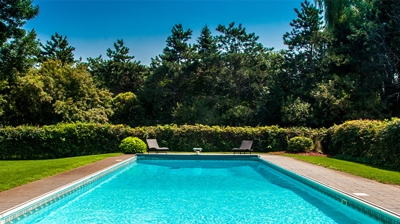- Thomas Pools
- Pool options ,
- September 26, 2025
Starting a pool construction project is both a major investment and an exciting new chapter for any Los Angeles homeowner. Turning a vision for a backyard retreat into reality means navigating a series of steps, important choices, and collaborations. When you understand what will happen—and why—at every phase, you’ll move forward with less stress and a clearer path to your dream pool. At Thomas Pools, we guide you through each decision, bringing two decades of experience and CBP certification to every build, so your backyard can become a uniquely personal escape you’ll enjoy for years.
Which Key Decisions Should Homeowners Make Before Starting Pool Construction?
Before any construction begins, several foundational decisions will shape your project’s outcome. First, align your budget with your vision by accounting for every aspect: excavation, materials, style, additional features, landscaping, and maintenance. Knowing your budget early lets you prioritize must-have features—such as spas, tanning ledges, or distinctive tilework—and plan for both essential and optional elements without overspending.
Think carefully about design preferences, as these determine both the look and the use of your pool. Will you want a geometric shape or a freeform lagoon? Would integrated water features, mood lighting, or eco-friendly systems enhance your experience? Consider how your household will use the pool every day, from recreational swimming to entertaining friends or hosting family barbecues. Every choice, from shape to surface finish, has practical and aesthetic implications for how your backyard feels and functions.
In Los Angeles & surrounding areas, neighborhood zoning and local codes will influence your plan as well. Setback requirements, easements, and property line regulations affect pool size and placement. Addressing these factors up front keeps your project on track, prevents costly mid-course corrections, and ensures you get a design that complies with regulations from day one. Working with a team that understands local requirements avoids confusion and unnecessary delays at permitting and inspection stages.
How Do Pool Permits & Regulations Impact Your Timeline in Los Angeles?
Permitting is a critical step in the pool construction process for any Los Angeles-area home. City departments review every detail—from site plans and engineering reports to plumbing & electrical designs—to ensure compliance with safety and environmental standards. Your application may also need to demonstrate compliance with water conservation rules unique to California, as well as ordinances governing barriers and access.
Expect permit review to take weeks or months, especially during busy construction seasons or if revisions are needed. Each city—whether Los Angeles, Santa Clarita, or elsewhere—may require different documentation such as soil tests, boundary surveys, and fence plans. Your pool builder manages much of this process, but your timely reviews and approvals can keep things moving. Being proactive about your role shortens the overall wait before breaking ground.
Inspections are an ongoing part of construction and occur at defined stages: after excavation, before and after steel/rebar work, and prior to finish installation. Each inspection must pass before moving forward, so coordination is essential. A builder like Thomas Pools—armed with CBP certification and deep knowledge of regional procedures—can streamline the process and help reduce the risk of costly missteps or failed inspections.
What Happens During a Pool Design Consultation & Site Assessment?
The first face-to-face meeting in the pool construction process is the design consultation & site assessment. This stage allows for a deep dive into your goals, practical needs, and personal style. Your builder visits your property to analyze key factors such as slope, soil type, access points, sunlight, drainage, and any unique challenges your yard may present. These observations influence everything from recommended pool placement to what kinds of features or pool shells work best for your property.
This initial assessment also includes a discussion of options for pool size, depth, water features, spa add-ons, automated controls, lighting, and more. At Thomas Pools, we take time to ask about your future plans—whether you envision growing families, frequent guests, or relaxation as the focus. Our CBP certification means we use up-to-date best practices in design, code compliance, and materials, helping identify added value or safety upgrades early on. By collaborating on design before the permit process, changes can be made with minimal disruption.
Once the assessment is complete, your builder provides a comprehensive design packet. This typically includes dimensioned plans, rendered images, cost breakdowns, and an outline of the anticipated construction timeline. Prompt agreement on design and specifications keeps your project moving and helps secure required permits with fewer rounds of revision. By setting clear expectations and details at this stage, both builder and homeowner minimize surprises and set the groundwork for smooth construction.
How Long Does Each Phase of Pool Construction Take?
Building a pool in Los Angeles or Ventura County isn’t a single-step process. Construction unfolds in a sequence of coordinated phases, each with unique timelines and requirements. After the necessary permits are in hand, excavation marks the official start, typically taking three to five days. However, properties with poor soil, limited access, or unexpected obstacles can require extra time, so open communication with your builder is important.
Following excavation, crews install rebar, rough plumbing, & electrical systems, which are all inspected by city officials before concrete or gunite is applied. Pouring or shooting the pool shell takes one to two days, but the material requires curing—usually a week or more—before further work. Next, tile, coping, and decking are installed to give the pool its finished appearance and safe, functional space around the water.
The final stages include installing equipment (like filtration, pumps, & robotics), completing plaster or pebble finishes, and filling the pool. Additional work might include landscaping, fencing, or additional hardscapes to complete the oasis. Most residential projects take eight to twelve weeks from start to finish, although complex custom features or delays (such as rain or permit bottlenecks) can influence this schedule. Throughout construction, Thomas Pools provides timely updates—so you stay fully informed at every milestone.
What Are Homeowner Responsibilities During the Pool Construction Process?
As a homeowner, your involvement is essential at every stage to ensure your pool construction project finishes strong. From finalizing design details to signing off on change orders or material selections, prompt decision-making helps the project stay on schedule. Delayed approvals—or changing your mind after a phase is complete—will typically increase costs and cause unnecessary holdups.
Ensuring clear site access stands among your most direct responsibilities. Whether that means removing garden furniture, providing gate codes, or arranging to move cars on delivery days, proactive preparation supports both safety and efficiency. Each city inspection is scheduled in advance, and some require your presence on site for access or approval. Being available on request maintains project momentum and avoids delays in building approval.
Monitor payment schedules closely, as milestones usually align with phase completions—such as after excavation, gunite installation, or tile work. Transparent, timely payments simplify communication and reduce financial stress. Ultimately, homeowners who engage and communicate openly with the construction team feel more empowered, more satisfied, and more likely to enjoy the completed pool and all its benefits.
How to Ensure Your Pool Is Safe, Code-Compliant & Durable
Pool safety and durability go hand-in-hand—and both start with careful construction and adherence to code. Hiring a CBP-certified builder like Thomas Pools means your project consistently meets the highest industry standards for installation practices, equipment selection, and on-site safety. Our team keeps up with evolving Los Angeles codes covering barrier heights, anti-entrapment drains, and GFCI-protected circuits, as well as emerging best practices for energy efficiency and eco-friendly technology.
During the build, every critical phase is subject to city or county inspection, ensuring that crucial details—such as plumbing integrity, steel placement, or bonding—are all verified by a third party. Features like self-closing gates, approved fencing, automatic covers, and safety signage are incorporated at required points so your pool passes every inspection and protects your household from day one. Partnering with a credentialed builder boosts your peace of mind and reduces risk for your investment.
Durability also comes down to materials and ongoing care. We recommend asking about warranties on finishes, equipment, and systems, as well as requesting a simple maintenance schedule tailored for your new pool system. Builders who offer guidance in this area set you up for years of safe, reliable fun—while also avoiding premature repairs or unwelcome surprises.
What Delays or Problems Can Affect Pool Construction Projects?
Constructing a pool in Southern California comes with certain risks and uncertainties. Delays are sometimes unavoidable, especially in these categories:
- Permitting or Inspection Backlogs: City agencies may require additional documentation, clarify property lines, or request design changes, extending approval times by weeks.
- Weather Interruptions: Heavy rain or extreme heat can halt work, especially during excavation and concrete application.
- Hidden Site Conditions: Rocks, tree roots, underground utilities, or overlooked drainage problems can emerge only once excavation begins and often require changes in the project plan.
- Supply Chain Issues: Ongoing disruptions in materials availability—especially for imported finishes or specialized equipment—may delay progress despite best efforts to plan ahead.
Staying flexible and maintaining open dialogue with your builder are the best strategies to keep your project moving. At Thomas Pools, we keep you informed about the status, potential problem areas, and realistic remediation steps if complications appear. The goal is not to eliminate all surprises, but to manage them efficiently so you never feel left out of the process.
Proactive involvement by both homeowner & builder means that even when challenges arise, solutions quickly follow. Understanding potential setbacks in advance builds resilience into your timeline—and helps you manage your own expectations, making the final reveal even more rewarding.
How to Manage Design Changes & Upgrades After Construction Begins
Even with careful pre-planning, you may decide to change your pool’s design or add new features during construction. This process is managed through “change orders,” a formal way to update original plans, specify new features, and clarify any adjustments to pricing or scheduling. Promptly communicating your ideas ensures they are considered
Call Thomas Pools now at (661) 495-9030 or send us a message online.

